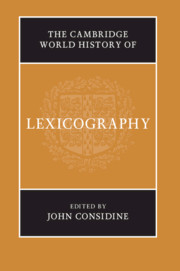Book contents
- The Cambridge World History of Lexicography
- The Cambridge World History of Lexicography
- Copyright page
- Contents
- Contributors
- Editor’s Acknowledgements
- Introduction
- Part I The Ancient World
- Part II The Pre-Modern World
- Part III The Modern World: Continuing Traditions
- 15 China from c. 1700
- 16 Japanese, Korean, and Vietnamese from c. 1800
- 17 Turkish and Persian from c. 1700
- 18 South Asia from c. 1750
- 19 Arabic from c. 1800
- 20 Modern Hebrew
- 21 The Slavic and Baltic Languages
- 22 The Germanic Languages Other than English from c. 1700
- 23 Standard Varieties of English from c. 1700
- 24 Regional Varieties of English
- 25 The Romance Languages from c. 1700
- Part IV The Modern World: Missionary and Subsequent Traditions
- Appendix 1 The Language Varieties
- Appendix 2 The Lexicographers
- Primary Sources
- Secondary Sources
- Index
25 - The Romance Languages from c. 1700
from Part III - The Modern World: Continuing Traditions
Published online by Cambridge University Press: 01 September 2019
- The Cambridge World History of Lexicography
- The Cambridge World History of Lexicography
- Copyright page
- Contents
- Contributors
- Editor’s Acknowledgements
- Introduction
- Part I The Ancient World
- Part II The Pre-Modern World
- Part III The Modern World: Continuing Traditions
- 15 China from c. 1700
- 16 Japanese, Korean, and Vietnamese from c. 1800
- 17 Turkish and Persian from c. 1700
- 18 South Asia from c. 1750
- 19 Arabic from c. 1800
- 20 Modern Hebrew
- 21 The Slavic and Baltic Languages
- 22 The Germanic Languages Other than English from c. 1700
- 23 Standard Varieties of English from c. 1700
- 24 Regional Varieties of English
- 25 The Romance Languages from c. 1700
- Part IV The Modern World: Missionary and Subsequent Traditions
- Appendix 1 The Language Varieties
- Appendix 2 The Lexicographers
- Primary Sources
- Secondary Sources
- Index
Summary
This chapter presents the history of the lexicography of the Romance languages, from the eighteenth century to the present day. In practice, emphasis is placed on French, Italian, and Spanish, together with Portuguese and Romanian. Behind these languages of the first rank, there are other languages, which will as far as possible be mentioned in this discussion.
Historians of the Romance languages distinguish the Gallo-Romance linguistic domain (comprising French, Francoprovençal, Occitan, and Gascon), the Italo-Romance domain (Italian, Friulian, Ladin, and Romansh), and the Ibero-Romance languages (Spanish, Portuguese, Galician, Asturian, Aragonese, and Catalan), to which I add the Romanian domain (divided grosso modo into two main varieties, Daco-Romanian and Aromanian) and Sardic. If one likewise takes account of the geolinguistic varieties present within these various linguistic domains, the number of Romance language varieties capable of being made the objects of lexicographical description is considerable.
- Type
- Chapter
- Information
- The Cambridge World History of Lexicography , pp. 530 - 552Publisher: Cambridge University PressPrint publication year: 2019



